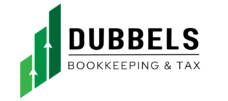Take Your Finances a Step Further by Partnering with Us
We offer a wide variety of services, easily customizable to fit your business and circumstances. Continue below to see all we have to offer and learn more about how Dubbels Bookkeeping & Tax can contribute to your growth and success.
Let us take over your bookkeeping tasks, so that you can focus on what you do best: Growing your business. Partner with us and trust that your books will be well-maintained. To the right is a summary of the services we provide.
- Monthly financial account reconcilliation
- Timely invoice issuance and accounts receivable reporting
- Timely bill payments
- Ensuring accurate and timely payment
- Managing employees financial records
- Contractor payments
- Quarterly tax filing
- Maintaining accurate records of receivables, inventory, prepaids, investments, equipment, furniture, etc.
- Calculating depreciation
- Ensuring assets are efficiently utilized
- Maintaining accurate records of payables, loans, in trusts, and business-owed taxes such as sales and payroll
- Effective financial planning
- Ensuring compliance with reporting standards
- Proper transaction categorization in the chart of accounts, informed by tax requirements
- Estimated tax calculation and payment
Whether you're using Quickbooks, Xero, or just have a few speadsheets handy, we will work with you and whatever software you prefer.
Tax Preparation & Filing
Tired of struggling through DIY software or waiting for the CPA to call you back? We’ve got you covered. With Dubbels Bookkeeping & Tax, your return being filed timely and accurately is our main priority. We have the knowledge and expertise to practice in all 50 states, so you can rest assured that your taxes will be in compliance while also maximizing your savings.
We use Intuit ProConnect and a secure online portal for uploading all sensitive documents, so your information will be kept safe and private. As a remote firm, we’ve made the e-filing process simple and seamless. Want tax season to feel like a breeze? Sign on with us today!
- Form 1040
- Schedule A, Itemized Deductions
- Schedule B, Interest & Dividends
- Schedule D, Capital Gains/Losses
- Schedule E, Supplemental Income
- Sole proprietorships: Schedule C, Profit & Loss (1040)
- Partnerships: Form 1065
- S Corporations: Form 1120S
Financial Analysis & Forecasting
Planning and tracking financial goals through forecasting and analysis are sophisticated strategies we employ to ensure your business reaches its maximum potential. These approaches aim to enhance revenue, reduce expenses, and expand business operations, contributing to long-term financial health and growth. Here’s an in-depth look at each strategy:
- Prepare Balance Sheet, Income Statement (P&L), Cash Flow Statement, and Statement of Retained Earnings
- Review and discuss each statement as it relates to the business’ financial health and opportunities for growth
- Determining the most relevant KPIs that align with the company’s strategic goals and operational objectives
- Gathering accurate and timely data to measure against each KPI
- Assessing the data to evaluate performance against predefined targets or industry benchmarks
- Communicating the outcomes in an understandable format to stakeholders to inform decision-making
- Using the insights gained from KPI tracking to make informed decisions, implement improvements, or adjust strategies
- Product Segmentation: Dividing the business’s offerings into distinct products or product lines to analyze their performance, profitability, and market demand separately. This helps in identifying which products are performing well and which may need improvement or discontinuation.
- Customer Segmentation: Grouping customers based on various characteristics such as demographics, buying behavior, or needs. This allows for tailored marketing strategies, personalized communication, and improved customer satisfaction by addressing specific needs and preferences of different customer groups.
- Vendor Segmentation: Categorizing vendors or suppliers based on criteria such as product quality, delivery times, and reliability. This aids in supply chain optimization, risk management, and strategic sourcing by prioritizing relationships with key vendors and identifying potential areas for improvement or cost savings.
- Project Segmentation: Organizing projects based on type, size, customer, or other relevant criteria. This facilitates better project management and resource allocation by allowing for a focused approach to managing timelines, budgets, and project-specific risks.
- Maximize deductions
- Timing expenses
- Prioritizing tax credits when available
- Avoid unnecessary taxable events
- Capital gains planning
- Maximizing retirement contributions
- Gift and estate planning
- New Capital Investments: Investing in new capital assets (e.g., equipment, technology, or facilities) can improve efficiency, increase production capacity, and enhance product or service quality.
- Cost Saving Efforts: Cost-saving initiatives aim to improve the bottom line by reducing expenses without compromising product or service quality.
- New Market Entry: Entering new markets can offer growth opportunities by reaching new customers or offering products/services in regions with less competition. Tracking involves measuring market entry success through metrics such as market share growth, sales performance, and customer feedback.
- Identifying Software Solutions: This could range from enterprise resource planning (ERP) systems, customer relationship management (CRM) software, to specialized tools for project management or accounting.
- Process Enhancements: Begin with a thorough mapping and analysis of existing processes to identify bottlenecks, redundancies, or inefficiencies. Apply lean management principles to eliminate waste and streamline operations. Automate repetitive, time-consuming tasks where possible to free up human resources for more strategic activities.
- Data Analytics & Reporting: Implement data analytics tools to gather insights from business operations, customer interactions, and market trends. These tools can help in making data-driven decisions, forecasting future trends, and identifying areas for improvement.
To help your business reach new heights, we're proficient in various softwares such as Asana, Bill.com, ClickUp, Tableau, and Knime.
Accounts Catch-Up/Clean-Up
The accounts catch-up/clean-up process is not merely a corrective measure but an opportunity to enhance financial management practices, improve the accuracy of financial reporting, and strengthen the financial health of the business. We offer comprehensive clean-up projects going back up to five years. To the right are the steps we take to get your business back on track.
- Assessing the extent of catch-up or clean-up required by reviewing the current state of the financial records. This includes identifying any missing documentation, outdated entries, or unrecorded transactions.
- Prioritize areas that need immediate attention, such as overdue invoices, unreconciled bank statements, or pending tax filings.
- Develop a plan outlining the tasks to be completed and any important deadlines.
- Collect all necessary financial documents, including bank statements, invoices, receipts, and any other relevant records.
- Ensure all transactions are accurately recorded in the accounting system. This step may involve cross-referencing bank statements with ledger entries and verifying the accuracy of invoices and receipts.
- Reconcile bank and credit card statements with the ledger entries to ensure that all transactions are accurately reflected in the accounting system.
- Identify and correct any discrepancies, errors, or omissions.
- Update the financial statements, including the balance sheet, income statement, and cash flow statement, to reflect the corrected and updated financial data.
- With updated financial statements, analyze the company’s financial health to identify trends, areas of concern, and opportunities for improvement.
- Implement or strengthen internal controls to prevent future discrepancies and ensure ongoing accuracy in financial reporting.
- Establish a routine for regular bookkeeping maintenance to avoid future catch-up or clean-up situations.
Let Our Services Help Your Business Succeed

We'd Love to Hear From You
Schedule an initial consultation or reach out to learn how Dubbels Bookkeeping & Tax can specifically benefit your business.

